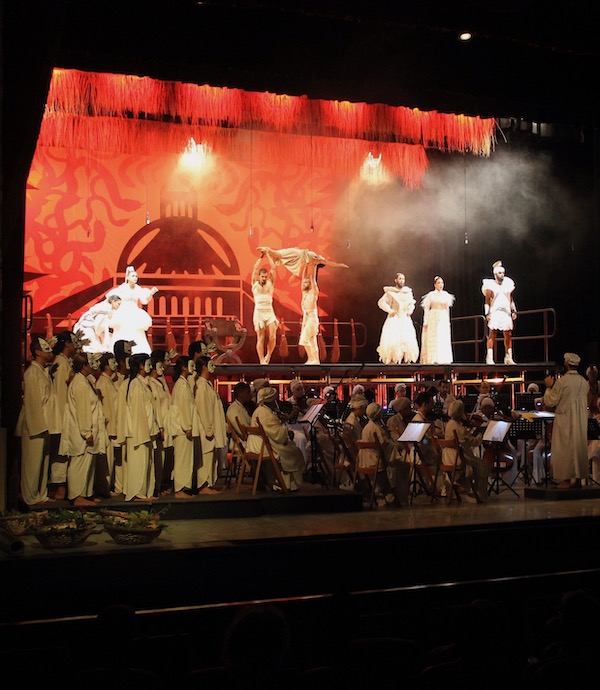Havana Lyceum Orchestra presents busy, revisionist production of Mozart’s “Clemenza di Tito”

In some ways La Clemenza di Tito is a fantasy about how life under a dictatorship could be not only tolerable, but good. Last October the Havana Lyceum Orchestra premiered a new adaptation of Mozart’s late opera seria at the 5th Havana Festival, set not in Rome but on the island of Cuba. The group has brought the production to the Kennedy Center as part of the World Stages series, seen Thursday night in the Eisenhower Theater.
Mozart composed the work in the last year of his short life, in honor of the coronation of Emperor Leopold II, who had succeeded to the throne after the death of his brother, Josef II. The flattering subject of the “virtuous emperor” Titus, who pardons the members of a plot to assassinate him, was an easy choice.
Cuban playwright and poet Norge Espinosa made this Cuban adaptation by replacing the recitatives with Spanish dialogue. (The recitatives, composed by an assistant due to the short time Mozart had to complete the commission, are no loss.) To make the new Cuban locale more apparent, some other numbers in the opera have been cut, in favor of excerpts from pieces by Cuban composers Jenny Peña Campos, Calixto Álvarez, and Guido López-Gavilán, arranged by Rogelio Riojas-Nolasco.
José A. Méndez conducted the Havana Lyceum Orchestra who were seated onstage–all wore white toga-like costumes to make them fit in with the rest of the staging. The action played out mostly on a platform raised above and behind the orchestra, with some scenes in the proscenium area in front of the orchestra. Amplification applied when the singers were behind the orchestra made it difficult to judge the quality of the voices, but the mostly young artists performed ably.
Tenor Bryan López’s sweet-toned tenor, floating and light on the high notes, combined with a tall, handsome stage presence to give the impression of an idealistic ruler somewhat out of touch with reality. Passages in rapid runs smudged together with some imprecision at times, but the slow aria “Del più sublime soglio” in Act I was admirably serene.
Anyelin Díaz plied her biting soprano voice, from acid-tongued high notes down to most of the needed low notes, to the poisonous Vitellia, who instigates the cabal to kill Tito. Her showpiece aria “Non più di fiori,” near the end of the second act, featured the agile side of her voice.
Clarity at high speeds sometimes eluded soprano Cristina Rodríguez, but her Sesto, the emperor’s best friend and confidant (a role created by a castrato), produced the most consistently beautiful tone.
Countertenor Lesby Bautista had some success negotiating the heights called for in the role of Annio, Sesto’s friend, created as a soprano trousers role. His accuracy and intonation wavered, especially in the more bitter top notes. Similar problems cropped up in the brittle soprano of Kirenia Corzo’s Servilia, who wants to marry Annio but is chosen as Tito’s bride. Given the struggles of bass Ahmed Gómez, the role of Publio, commander of the Praetorian Guard, should have been cut, a move that would cause no perceptible loss to the story.
Carlos Diaz directed a busy, colorful, often surprising production with simple, abstract set backdrops (designed by Raúl Valdés) and humble costumes halfway between Cuba and Rome (Celia Ledón). Taking a cue from the static nature of much opera seria, the singers generally refrained from much movement, their blocky costumes and painted mask-like faces making them seem like living bunraku puppets. A dancer even carried Sesto on and off stage.
As compensation three dancers from Compañía OtroLado distracted the eyes during almost every musical piece. The athletic choreography by Norge Cedeño, a mixture of classical and modern movements, contrasted memorably with the stillness of the singers, often emphasizing the brutal handling of the lone woman dancer by the two accompanying men. Sometimes the dancers seemed to direct the movements of the singers, adding their arms from behind.
This overly active production came together most vividly in the three insertions of Cuban music, one of which included the chorus, here sung capably by members of NEWorks Voices of America Choir. The Havana Lyceum Orchestra played both the Mozart works and the Cuban pieces with a sometimes rough enthusiasm. The basset horn solos, played with verve and panache by clarinetist José Ernesto Rodríguez Delgado, stood out for particular praise.
La Clemenza di Tito runs through Saturday. kennedy-center.org; 202-467-4600



